Father Anthony Dattilo, pastor of St. Joachim Parish in Old Mines, commended the history of the parish, saying in a homily at Mass Sept. 12, “This was a Catholic community. People came to this spot to worship the Lord at Holy Mass. And we’re still doing that almost 300 years later, worshiping in the same spot.”
Residents of a small community in Washington County have maintained their French and Catholic heritage now for nearly 300 years as their parish embarks on celebrating its 200th anniversary.
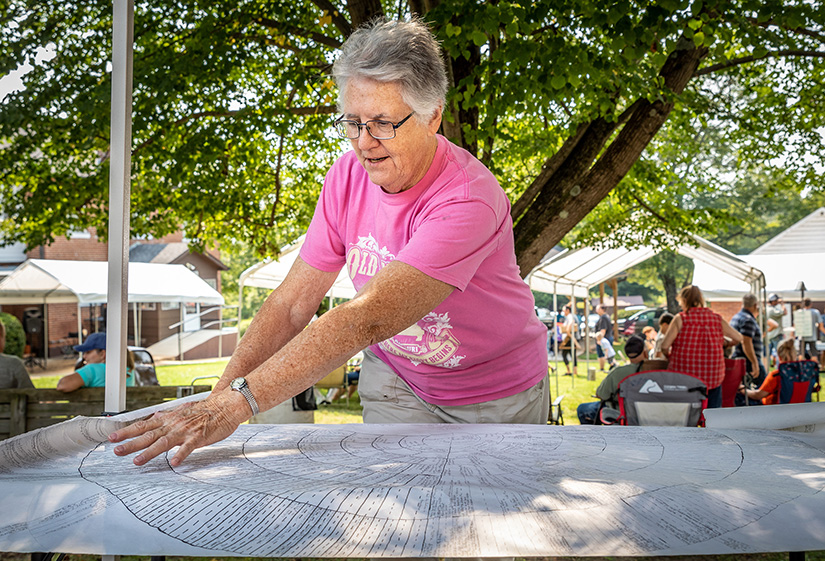 Mary Catherine Norbut explained her French heritage that dates back to 1542 using a genealogical map she made for display at festival day at St. Joachim Parish in Old Mines.Photo Credits: Lisa Johnston
Mary Catherine Norbut explained her French heritage that dates back to 1542 using a genealogical map she made for display at festival day at St. Joachim Parish in Old Mines.Photo Credits: Lisa JohnstonSt. Joachim Parish in Old Mines turns 200 years old next year. The church — the oldest in the archdiocese — will be 200 years old in 2031.
Natalie Villmer, a member of the Parish Workers of Christ the King, said “we are a product of our ancestors, what was important to them, their faith particularly — so we like to keep that alive, some of their traditions, a little of their language and songs.”
The town of Old Mines officially began in 1723 when Phillippe Francois Renault of France received a land grant to mine and smelt lead in the area. He reportedly brought 200 laborers from his homeland and Black slaves purchased in San Domingo.
The French population swelled in the 1760s when French settlers of Acadia (now called Nova Scotia) fled the Canadian provinces after the English imposed anti-Catholic laws. Religious needs of the Catholic people of Old Mines were served until the late 1700s by Jesuit priests who visited from Kaskaskia, Illinois. From 1793, priests from Ste. Genevieve served the people of Old Mines.
The Catholic Church supported and unified the population and a cultural and spiritual entity, playing a vital role in preserving the French language and ways.
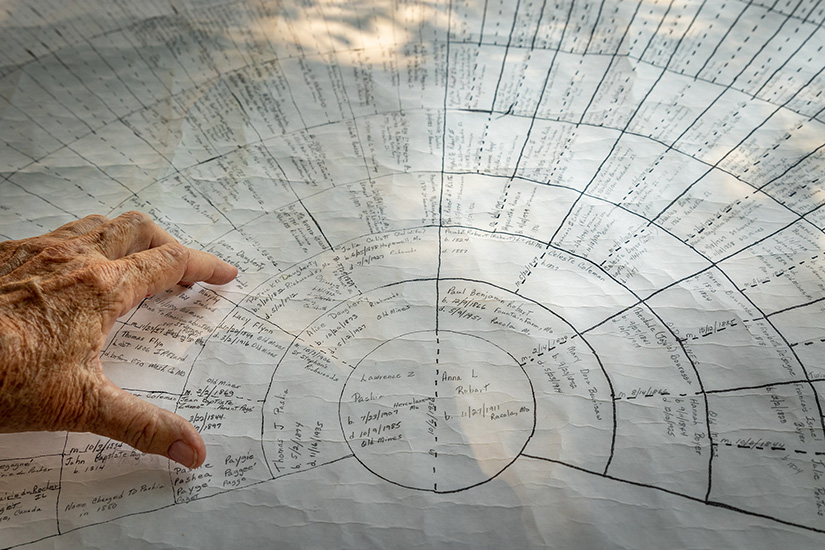 Mary Catherine Norbut can trace her genealogy back to the 1500s in France.
Mary Catherine Norbut can trace her genealogy back to the 1500s in France.The first church of which there are records is a log church constructed in 1821 by Father Henry Pratte from Ste. Genevieve. Construction of the present brick church began in 1828 under the direction of Vincentian Father John Boullier, the first resident pastor of St. Joachim. The church was consecrated by Bishop Joseph Rosati in October of 1831 and is the oldest church in the archdiocese still in use by a parish.
On Sept. 11, the eve of the annual parish festival, Father Jason Vidrine of the Diocese of Lafayette, Louisiana, celebrated a Mass at St. Joachim partially in French to kick off the anniversary celebrations. Father Vidrine celebrated Mass in French the next day at Fort de Chartres in Prairie du Rocher, Illinois, for its 300th anniversary.
Father Dattilo, pastor of St. Joachim, said in his homily at Mass on the festival day Sept. 12 that the first parishioners of St. Joachim heard Mass in Latin with the homily and perhaps the readings in French.
Mary Norbut was one of the volunteers staffing a booth at the festival helping people trace their heritage. Norbut, whose maiden name is Pashia, traces her family and Catholic lineage on her mother’s side to the 1500s in France and on her father’s side to 1604 in France. Her father’s family, French and Irish, was among the original families who moved to the area. Her father’s side also goes back to the chief of the Kaskaskia Indians.
As a young man, Norbut’s father worked at the parish and lived in a room at the rectory. Among other things, he tended the garden and would “saddle up a horse for the priest” to make visits to parishioners. At night he and the pastor researched the history of the parish. “They used the blueprints for this church to build the Old Cathedral on the St. Louis riverfront,” Norbut said.
Her father also told her about the restrictions on slaves, who only could come into church for Mass and had to sit on the side; they went to confession from the outside talking to the priest from a window that since has been covered with bricks.
Norbut’s great grandfather had 21 children. Ten were with his first wife who died in childbirth and 11 with his second wife. All five of the girls from the first marriage became Sisters of Loretto, joining three of their cousins.
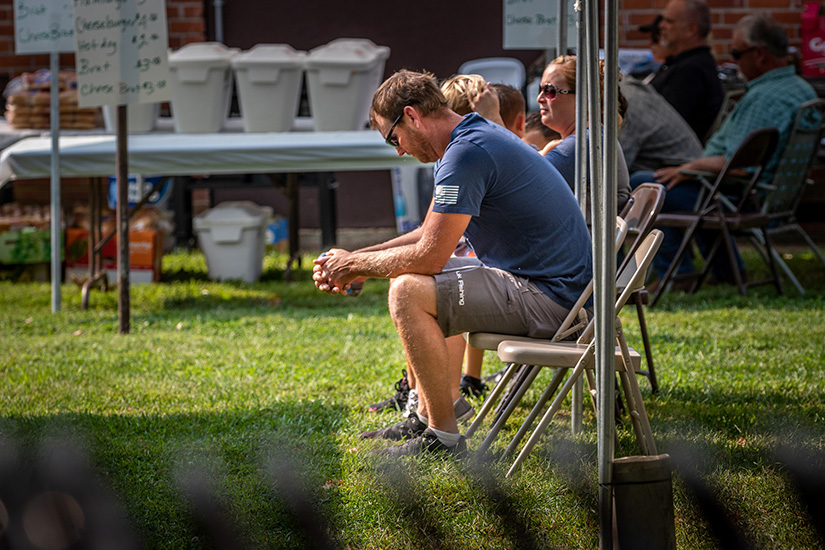 Matt Pinson prayed during an outdoor Mass at St. Joachim Parish in Old Mines on Sept. 12Photo Credits: Lisa Johnston
Matt Pinson prayed during an outdoor Mass at St. Joachim Parish in Old Mines on Sept. 12Photo Credits: Lisa JohnstonFather Mark G. Boyer, author of the recently published “300 Years of the French in Old Mines: A Narrative History of the Oldest Village in Missouri” and a native of Old Mines, said “you can’t separate church and community. They grew up together.”
Kent Bone said the history is unique to the state. No one speaks French as a first language anymore, he said, but a few people retain a limited vocabulary of words unique to the area for things such as climate, animals and occupations. Some of it is what he called “colonial French,” a dialect spoken throughout North America. He speaks modern French and the “Old French” from when there were hundreds of French speakers in the area.
The Bone family came to Old Mines to mine lead in the 1760s from Montreal and other parts of his family can be traced to the 1720s and 1730s. The parish was considered the spoke of the community. “It’s still the center of the community,” Bone said.
Gary Boyer, a 1969 graduate of St. Joachim High School, was one of eight children who grew up a mile down the road from the church in an area known as Recola, which had a store, barber shop, tavern and gas station. His parents were born there too, along with his father’s seven siblings and his mother’s 14 siblings.
Of the eight children in his family, three remained in the area. He is part of a group that take care of the St. Joachim property, including the three graveyards, all volunteer labor.
“This is where the church is, and everybody comes here,” Boyer said.
>> Old Mines and St. Joachim
The Old Mines area is in the foothills of the Ozarks about 50 miles west of the Mississippi River. Its history dates to the early 1700s when French explorers led expeditions up the rivers and into the woodlands searching for silver and lead.
A lead-mining settlement began in 1723 when Phillippe Francois Renault arrived from France with laborers and slaves to mine the rich mineral deposits. He stayed until 1742 when he lost his financial backing.
Some of the miners stayed in the area. Records tell of the spiritual care of the villagers by Catholic priests.
In 1796, the first application by settlers was made to the Spanish government for land grants. The area, 6 by 3 miles wide, was to be known as the Old Mines Concession and covered the same area given to Renault by the French government. Among the 31 families applying were names still found among Old Mines residents today. Auguste Chouteau, a founder of St. Louis in 1764, was among the applicants.
By the 1800s, more than 200 French families inhabited the village.
>> 300 years
The village of Old Mines is the oldest settlement in the State of Missouri, states Father Mark G. Boyer, a retired priest of the Springfield-Cape Girardeau. He is a native of Old Mines and author of “300 Years of the French in Old Mines: A Narrative History of the Oldest Village in Missouri” published by Wipf and Stock of Eugene, Oregon.
Lead miners were in Old Mines as early as 1719. The founding of Old Mines in 1723 coincides with the land grant awarded to Philippe Francois Renault by French authorities on June 26, 1723, to mine lead.
Father Boyer’s book narrates the history of people and how they have kept alive a French heritage of culture and customs. The history of Old Mines is tightly bound to the Catholic faith the French settlers brought with them, the parish they founded, and the church, schools, rectories and convents they built.
Father Boyer will sign copies of his book available for purchase during the Old Mines Area Historical Society’s La Fete d’Automne, Sunday, Oct. 3, 10 a.m. to 4 p.m.
Also, books can be ordered directly from the author: Fr. Mark G. Boyer, 1140 E. Stanford St., Springfield, MO 65807-2058 for $31 plus $5 postage and handling; include a check payable to Mark G. Boyer for the total amount of $36 per book. Books also can be ordered either online or by phone for $31 plus shipping and handling from wipfandstock.com, (541) 344-1528.
>> Timeline
1700 — Jesuit Father James Gravier, in his missionary exploits, comes near the Old Mines area. In letters to his superiors in France, he mentions the vast amount of lead found there.
1714 — Claude DuTisne makes a trip across present Washington County following an old Native American trail, returning with lead ore samples.
1723 — Phillippe Francois Renault of France received a land grant to mine and smelt lead in the area. He reportedly brought 200 laborers from his homeland and Black slaves purchased in San Domingo.
1742 — Renault leaves after suffering financial difficulties. Tradition has it that many miners stayed behind.
1821 — Vincentian Father Henry Pratt builds a log church in Old Mines. Tradition states there were three log churches before the present brick one was built, with parishioners served by missionaries from Ste. Genevieve and Kaskaskia. The same year, Missouri enters the Union.
1828 — Vincentian Father John Boullier begins construction on St. Joachim Church and become the first permanent pastor to reside continuously in Old Mines. Bricks for the church are made from clay nearby.
1831 — Bishop Rosati dedicates St. Joachim Church.
1841 — Father John Cotter, first diocesan priest assigned to Old Mines, become pastor. He had knowledge of medicine and traveled Washington County bringing corporal and well as spiritual help. Ten years later, he was killed when his horse threw him against a tree.
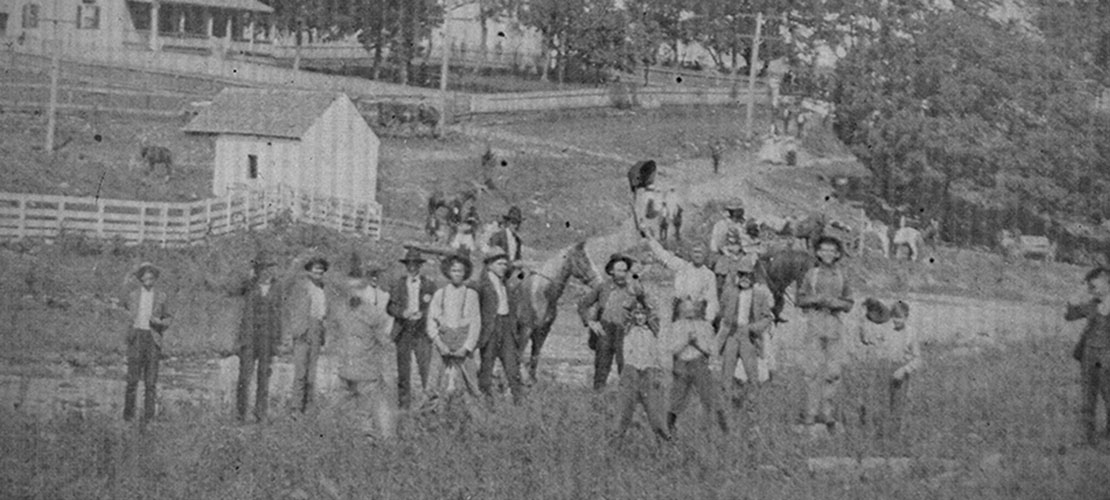 Men worked on the steeple at St. Joachim Church in Old Mines in 1900.Photo Credits: Archdiocesan Archives photo1866 —
Men worked on the steeple at St. Joachim Church in Old Mines in 1900.Photo Credits: Archdiocesan Archives photo1866 — A use is found for a mineral in the area called tiff or barite. Most of the people stay in the area where they are born. Some farm, growing wheat, tobacco, sugar cane, corn or other items. Some hunt, mine and fish. They preserve many of the customs they brought from Canada and France.
1924 — The Sisters of Charity of the Incarnate Word arrive in Old Mines. The first day of school is in the new frame convent/school building with 109 students.
1930s — French is still spoken in the vast majority of homes.
1949 — The cornerstone of the new school is laid. The Rural Parish Workers of Christ the King, a secular institute of the archdiocese, move to the area, responding to a request to serve the people of St. Joachim Parish. Founded in 1942, they give service to neighbor.
1950 — Very little French is spoken in the homes, only older members of the family continue to speak it and only a few old customs of French folk tales live on.
1970s — St. Joachim High School closes.
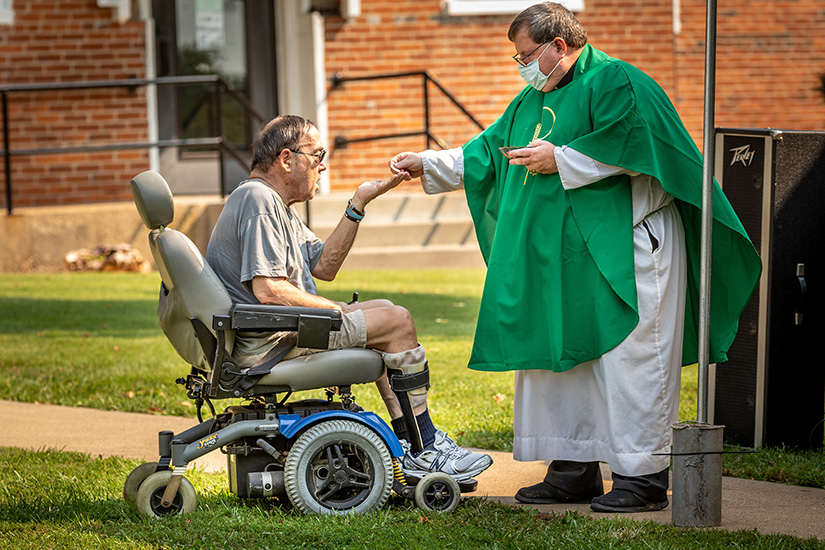 Father Anthony Dattilo, pastor of St. Joachim Parish in Old Mines, distributed the Eucharist to Eddie Coffey during an outdoor Mass at the church.Photo Credits: Lisa Johnston
Father Anthony Dattilo, pastor of St. Joachim Parish in Old Mines, distributed the Eucharist to Eddie Coffey during an outdoor Mass at the church.Photo Credits: Lisa Johnston